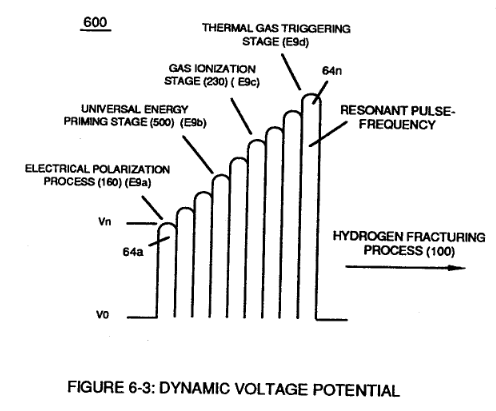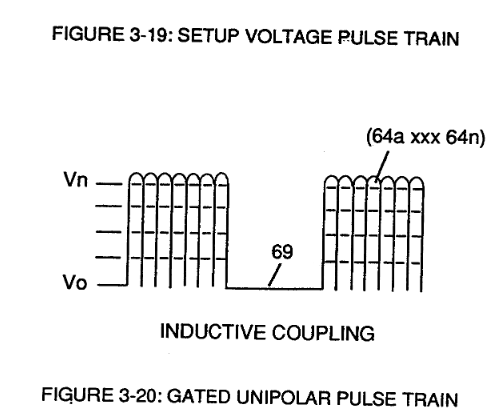8-1 - Propagating "Resonant Action" By Voltage Tickling of State Space
Voltage Wave-Guides
Propagating "Resonant Action"
By Voltage Tickling of State Space
 The "mode-of-operability" of determining the "operational parameters" of releasing thermal explosive energy (gtnt) (flame force-yield) in direct relationship to thermal heat-yield (flame temperature) beyond applied voltage pulse-frequency of opposite polarity intensity (farthest from state of equilibrium) is effectuated by simply changing or altering the physical configuration of the "Voltage Wave-guides" (Resonant Cavity structure of design) in direct reference to applied ever changing Unipolar Voltage Amplitude Pulse-Wave (see Figure 6-3 of WFC memo 425) to bring-on and propagate a predetermine flame-density of projection by pre-selecting the "State Space" in which the injected and incoming water bath is subjected to performing work of instantly converting water into thermal explosive energy (gtnt) on demand... using water as fuel.
The "mode-of-operability" of determining the "operational parameters" of releasing thermal explosive energy (gtnt) (flame force-yield) in direct relationship to thermal heat-yield (flame temperature) beyond applied voltage pulse-frequency of opposite polarity intensity (farthest from state of equilibrium) is effectuated by simply changing or altering the physical configuration of the "Voltage Wave-guides" (Resonant Cavity structure of design) in direct reference to applied ever changing Unipolar Voltage Amplitude Pulse-Wave (see Figure 6-3 of WFC memo 425) to bring-on and propagate a predetermine flame-density of projection by pre-selecting the "State Space" in which the injected and incoming water bath is subjected to performing work of instantly converting water into thermal explosive energy (gtnt) on demand... using water as fuel.
The established "State Space" is governed by either one of two variables being of either "Static" or "Dynamic" state of condition.
Dynamic State condition is a variable of condition that is changing all the time; whereas, Static variable of condition is set at some point but then never changes.
A point in "State Space" represents the state of the flame-system at a given time and is either in an synchronized and synchrony movement. Interaction of either "Static State Space" or "Dynamic State Space" in similar state of conditions or opposite conditions of "states" allows "Energy-Vectoring" of the hydrogen flame-front or flame projection of trajectory ... establishing an interrelationship on how to design retrofit the water fuel injector® to any existing type of energy consuming device.
Static variables condition is established when the resultant gas pressure is held constant with the never-changing static electrical stress of opposite polarity of Voltage Pulse-Wave (64) of Figure (3-20) of WFC memo 422DA.
Dynamic variable conditions exist when both the applied electrical stress of opposite polarity and dynamic gas pressure are continually changing in a preset time frame. Where, Combinatorial variable conditions is a "State Space" function of subjecting constant static gas pressure to an ever-changing electrical stress of opposite polarity (RR'-SS').
And, Differential dynamic variables condition of"State Space" is accomplished whenever changing dynamic electrical stress of opposite polarity (RR'-SS') encounters a negative (decrease/drop-in) dynamic gas pressure. In each and all "Space State" of changes, the combustible gas atoms of water is/are "Electrically Stressed" under "different" pressure levels to bring-on the triggering point of thermally igniting the combustible gases of water beyond or away from "Stable State" of Equilibrium.
Voltage Tickling of State Space under "Resonant Electrical Stress" without amp influxing while "Tuning-ln" to the dielectric properties of water is herein referred to in this WFC Tech-manual as "Resonant Action."

